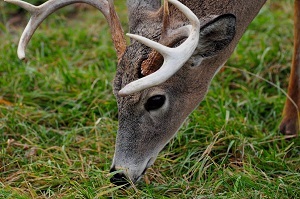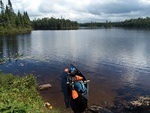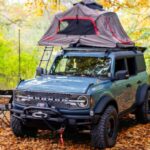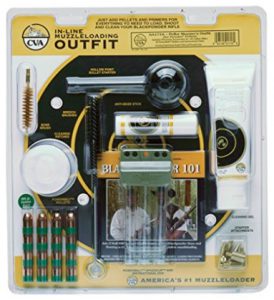
Several years ago I started muzzleloader hunting for whitetail deer in Wisconsin. Wisconsin has an archery season, a nine day regular gun season, and a muzzleloader only season. The muzzleloader only season is seven days long and follows the nine day regular gun season.
I found that the muzzleloader only season is a great time to be out in the woods. For me it’s about two things; being out in nature, and not having to share the woods with a lot of other hunters. The muzzleloader season hardly sees anyone in the woods, and I like that.
It was thirty years ago in my early to mid teens that my father got interested in traditional muzzleloaders. He bought a Thompson Center kit gun, and we would both go to the range to shoot our ‘smoke poles’. It was a lot of fun. However, for deer hunting I use a modern inline muzzleloader, and I’ll go into that further below.
Disclaimer: If you are thinking about getting in muzzleloader hunting, not just for deer, but for any wild game, be sure to check your State’s laws and regulations. As I continue to write this post, I will be writing based on hunting in Wisconsin.
Muzzleloader Hunting For Whitetail Deer In Wisconsin
I tell you what, between the archery season, regular nine day gun season, and the muzzleloader only season, the hardest season to hunt and be successful in is the muzzleloader season.
In the archery season I know what the deer are doing, where they bed down and where they go to eat. I know how to hunt them based on their travel patterns that I scout out in the months prior to hunting.
In the nine day regular gun season I just sit on my butt in my blind because I hunt public land. Other hunters that walk into and out of the woods when they get cold push the deer around… I see a lot of deer just by hunkering down and waiting for them to walk by.
During the black powder muzzleloader only season, which starts as soon as the nine day regular gun season ends, the deer are spooked and on edge from all kinds of people being in the woods the week before. So they tend to stay in thick cover and not move at all during the daylight hours. There is hardly anybody in the woods as most hunters don’t hunt this particular season, so nobody is moving deer around.
In order to be successful during the black powder only season, I need to do what is called ‘still hunting’.
Still Hunting Whitetail Deer With A Muzzleloader
When you hear somebody mention ‘still hunting’ the thought that comes to mind is not moving when you hunt, to be completely still. Well, still hunting is most certainly not about sitting or standing still.
Still hunting is actually what hunters do when they want to stalk the animal they are hunting. Hunters who are proficient at still hunting are some of the best hunters around. They rely on their skill to track animals, as well as their senses to see, smell, and hear their prey before they themselves are detected by the animals they are hunting.
During the muzzleloader season I still hunt 80% of the time. In fact, the only time I have ever seen deer during the black powder season is when I have been trying to stalk them. Sitting in a stand during this season has never produced any deer for me, ever.
Still Hunting Skills And Tactics For The Muzzleloader Season
There are a few things that can help a person successfully still hunt. The first thing to keep in mind is you have to move very slow and quietly when still hunting. The odds are that whitetail deer are going to detect you long before you see them. So you have to do things that work in your favor.
During the daylight hours after the nine day regular season the deer are not moving. They move more at night, or in the early dawn and late dusk. But during the day they tend to bed down in thick cover.
Things to keep in mind to successfully still hunt:
- Move slowly and quietly: You don’t want to be seen or heard. I usually take a handful of slow steps then stop and stand still at the ready for a minute or longer while I can the area, listen, and smell the wind. Sometimes I see the deer before they see me. Usually I don’t. However, by moving slow like this I am not overly spooking the deer and sending them running. Like I said they are usually bedded down. If I am moving slow they tend to just stand up and take a few steps as they watch me approach, when they do that I can see them and might get a good shot. If I am moving too fast they are more prone to bolt and run before I see them, or when I can barely see them through the woods. I don’t shoot at running deer.
- Always hunt the wind: This one is very important. It needs to constantly be on your mind with still hunting. Like I mentioned deer are usually bedded down during the day when the muzzleloader only hunt is in affect. You want to stalk and approach the deer from downwind. If you are downwind from them they cannot smell you. Also, depending on how strong the wind is, it can help conceal your sound as it pushes sound away from the deer, as opposed to carrying it towards them. Always make sure to hunt moving into the wind. You want the wind in your face.
- Watch for deer tracks: In Wisconsin I have it pretty easy, usually. The black powder only season usually starts at the end of November and goes into the first week of December. Usually there is snow on the ground, not always, but usually. If I am lucky there will be a recent snow the night before I hunt. This allows me to see fresh deer tracks in the snow and know where to hunt. Of course when there is no fresh snow, or any snow at all, like what I have before me this 2017 season, I need to look for tracks in the dirt or ruffled leaves, or along trails. Usually, with experience and a careful eye, I can tell which tracks are more recent – sometimes it’s just luck.
- Watch for deer: I know, this one is obvious. But you really need to be watching carefully for outlines of deer. I tend to look for horizontal angles while still hunting. The woods are filled with trees that are standing tall, sure, some are knocked down, but most are vertical. So I look for horizontal angles. I also watch for deer ears flickering, and horns on heads that are turning. I think about what I am looking for, and watch for slight movements around horizontal angles. If I can see the deer while they are bedded down, it increases my chances of a harvest.
How To Get Started In Muzzleloader Hunting Deer
Most states have muzzleloader only seasons. You can also use a muzzleloader during most regular gun seasons. Be sure to check your local laws. I know in Wisconsin what the laws are, in fact I wrote about muzzleloaders and if felons can use them to hunt here.
If interested in getting into muzzleloader hunting for whitetail deer, it is a fairly easy thing to get started. It’s also a little more challenging, which is another aspect I like. You have to be sure of your shot, as you only have one chance to get it right. Reloading after taking a shot can take some time, makes noise, and requires movement. So forget being stealthy if you need to be when reloading quickly.
As the name implies, you load a muzzleloader from the muzzle of the gun. There are traditional muzzeloaders, and then there are modern inline muzzleloaders. I own both types, but use a modern inline muzzleloader to hunt deer.
The Basics Needed To Get Started
There are really only a few basic things you need to get started using a muzzleloader. But of course there are some accessories that make it easier along the way.

Here are the basics:
- You need a muzzleloader! They can get expensive for high end models, but there are also some lower end models that are very affordable. I have two inline muzzleloaders, but only one is my go to rifle for whitetail deer hunting, and that is a CVA WOLF 50 Caliber. They come with a few different stock color options, as well as in blue or stainless steel. Mine is a bottom of the line model with black poly stock. It’s rather light to carry and very maneuverable, which I like when still hunting. A new one costs around $200. If new to muzzeloading I would strongly consider getting an entry level gun like this one. I have found that it is also all I need for successful whitetail deer hunting in Wisconsin. You can buy one here online.
- You need bullets to shoot through your gun! But you also need a few items to help you clean it as well. Muzzleloaders are very dirty to shoot, and should have cleaning patches ran through them every three or four shots. They also need to be thoroughly cleaned before being stored. Luckily CVA makes a starter kit that sells all the basics you need to do all of those things. And the price on it is pretty darn good for all the items you get. The only thing the kit does not have in it is the powder you need to propel your bullets, as well as the primers to fire the gun. The starter kit also has an excellent DVD that tells you all about using a black powder rifle… it’s highly informative. You can get the starter kit from Amazon here.
- Next you need powder to load into your muzzleloader to fire the bullets. Most people who use modern inline muzzleloaders us powder pellets. They come in various grain sizes, but most buy them in 50 grains. Sorry, I can’t provide a link to buy this online. It’s a hazardous material and not many online retailers carry it to be shipped – you can try Midway USA. Otherwise you will need to find a local sporting good store that carries this product. It is made by various manufactures, and everybody has a personal preference. So ask around at your local sporting goods stores about recommendations, or check Midway USA.
- The last thing you need is 209 primers. These are what are used to ignite the powder in inline muzzleloaders. These are also considered hazardous materials and have some shipping restriction, so many online retailers don’t mess with them. However, you can try Midway USA yet again for these.
Muzzleloader Hunting For Whitetail Deer – Conclusion
Hunting whitetail deer with a muzzleloader can be challenging. Most states have specific seasons for using these types of firearms to harvest deer. The average cost of buying the shooting equipment needed to get started costs about $250-$300.
If thinking about giving this type of hunting a try, I strongly suggest you get a muzzleloader well in advance of the deer season and practice. Learn all you can about operating a muzzleloader rifle, be it a modern inline model or one that is more traditional.
Take your time and get proficient with it. Make sure you are well aware of any laws for your State governing use of such firearms for hunting. Shoot often.
And always, no mater what, practice safe hunting and safe gun handling.
TD






